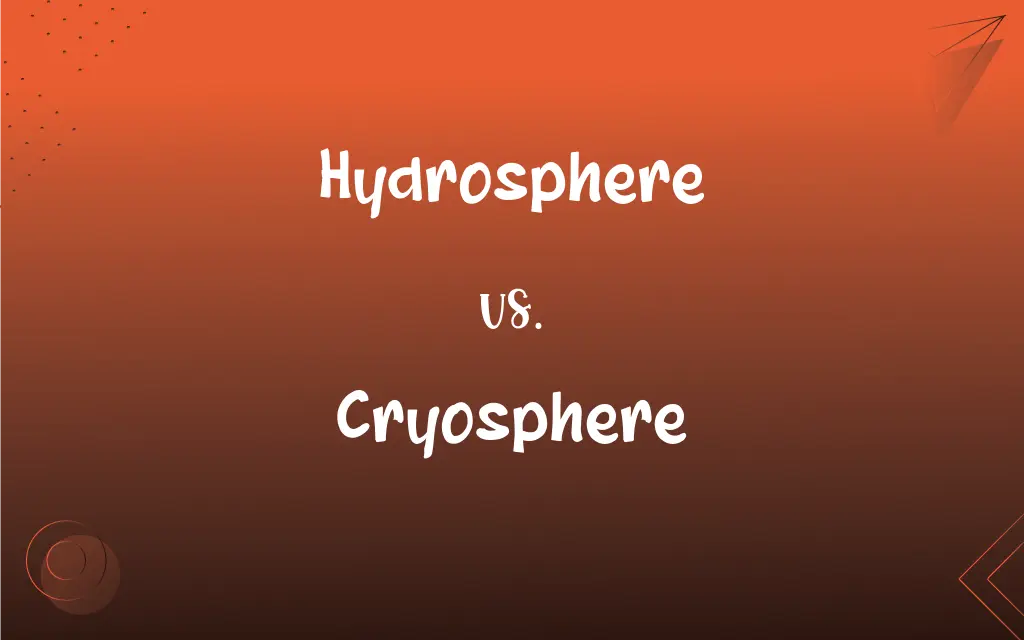Hydrosphere vs. Cryosphere: What's the Difference?
Edited by Harlon Moss || By Janet White || Updated on October 7, 2023
Hydrosphere encompasses all water on Earth’s surface, whereas Cryosphere refers specifically to Earth’s frozen water parts.

Key Differences
Hydrosphere and Cryosphere are two distinct components of the Earth’s system, relating to the distribution and state of water on the planet. The Hydrosphere includes all the water present on Earth’s surface, in all its forms—liquid, vapor, and ice. This encompasses oceans, seas, lakes, rivers, groundwater, and atmospheric water vapor. Conversely, the Cryosphere is specific to those parts of the Earth’s surface where water is in solid form, including glaciers, ice caps, snow cover, and permafrost.
The Hydrosphere is crucial for maintaining life on Earth as it provides the necessary water for survival to all living organisms. It plays a fundamental role in supporting ecosystems and regulating the planet’s climate. The Cryosphere, though more specialized, is equally significant, influencing global climate systems, sea levels, and providing habitats for specialized flora and fauna. It is integral to the Earth’s energy balance due to its reflective properties.
Delineating the Hydrosphere, its omnipresence is noteworthy, encompassing approximately 71% of the Earth's surface primarily as oceans, which hold about 97.5% of all Earth’s water. The Hydrosphere also includes fresh water found in lakes, rivers, and underground aquifers. In contrast, the Cryosphere’s domain is more restricted, occurring predominantly in the polar regions, high mountains, and beneath the ground as permafrost in cold regions, storing about 69% of the world’s fresh water.
The Hydrosphere and Cryosphere interact constantly, impacting weather patterns, ocean currents, and global climate. The Hydrosphere contributes to the water cycle, enabling the circulation and transformation of water throughout the Earth’s system. The Cryosphere interacts with other earth systems affecting temperature regulations and sea level through the storage and release of freshwater.
Both the Hydrosphere and Cryosphere are invaluable for scientific studies and climate research, offering insights into climate change and its impacts. They provide crucial data points and references for understanding variations in climate, helping scientists develop more accurate climate models and predictions. The changes in the Cryosphere, such as melting glaciers, are indicative of global temperature changes, and alterations in the Hydrosphere have vast implications on weather patterns and biodiversity.
ADVERTISEMENT
Comparison Chart
Composition
All water forms including liquid, vapor, and ice.
Specifically, the frozen water parts of Earth.
Location
Covers approximately 71% of Earth’s surface.
Predominantly in polar regions and high mountains.
Contribution to Life
Essential for all life forms.
Provides habitats for specialized flora and fauna.
Climate Impact
Regulates climate through water cycle contributions.
Influences global climate and sea levels via its reflective properties.
Percentage of Earth’s Fresh Water
Holds a small percentage of Earth's fresh water.
Stores about 69% of the world’s fresh water.
ADVERTISEMENT
Hydrosphere and Cryosphere Definitions
Hydrosphere
Hydrosphere is all water present on the Earth’s surface, including oceans, lakes, and rivers.
Oceans are the largest component of the Hydrosphere.
Cryosphere
Cryosphere refers to the frozen water parts of the Earth.
The Cryosphere includes glaciers and ice caps.
Hydrosphere
Hydrosphere includes water in all its forms—liquid, vapor, and ice.
The Hydrosphere is crucial for sustaining life on Earth.
Cryosphere
Cryosphere is predominant in polar regions and high mountains.
Antarctica is a major component of the Cryosphere.
Hydrosphere
Hydrosphere is vital for maintaining the Earth’s climate and supporting ecosystems.
The Hydrosphere contributes to the Earth’s water cycle.
Cryosphere
Cryosphere affects global climate systems and influences sea levels.
Changes in the Cryosphere are indicators of global climate change.
Hydrosphere
Hydrosphere encompasses atmospheric water vapor and groundwater.
Groundwater is an important part of the Hydrosphere.
Cryosphere
Cryosphere stores a significant portion of the world’s fresh water.
The melting of the Cryosphere contributes to rising sea levels.
Hydrosphere
Hydrosphere plays a pivotal role in regulating weather patterns and temperatures.
The interaction between the Hydrosphere and the atmosphere influences weather conditions.
Cryosphere
Cryosphere provides habitats for specialized ecosystems.
Many unique species are adapted to live in the harsh conditions of the Cryosphere.
Hydrosphere
The waters of the earth's surface as distinguished from those of the lithosphere and the atmosphere.
Cryosphere
All those areas of the Earth where the surface is frozen.
Climate change has a strong effect on the cryosphere.
Hydrosphere
The water vapor in the earth's atmosphere.
Hydrosphere
All the liquid waters of the Earth, as distinguished from the land and the gases of the atmosphere.
Hydrosphere
The aqueous vapor of the entire atmosphere.
Hydrosphere
The aqueous envelope of the earth, including the ocean, all lakes, streams, and underground waters, and the aqueous vapor in the atmosphere.
Hydrosphere
The watery layer of the earth's surface; includes water vapor
FAQs
Is the Cryosphere only found in polar regions?
Predominantly, but it also includes high mountains and other cold regions on Earth.
Does the Cryosphere influence global climate?
Yes, the Cryosphere significantly influences global climate systems and sea levels.
Is atmospheric water vapor part of the Hydrosphere?
Yes, atmospheric water vapor is a component of the Hydrosphere.
Does the Hydrosphere include all forms of water on Earth?
Yes, the Hydrosphere includes all forms of water—liquid, vapor, and ice on Earth’s surface.
Does the Cryosphere store a significant portion of fresh water?
Yes, the Cryosphere stores about 69% of the world’s fresh water.
Does the Hydrosphere regulate the Earth’s climate?
Yes, the Hydrosphere is vital in maintaining the Earth’s climate and weather patterns.
Does the Cryosphere reflect a significant amount of solar radiation?
Yes, the Cryosphere’s reflective properties are pivotal in the Earth’s energy balance.
Does the Hydrosphere play a role in supporting life on Earth?
Absolutely, the Hydrosphere is essential for supporting all life forms on Earth.
Is the Cryosphere important for climate studies?
Indeed, the Cryosphere is crucial for studying climate change and its impacts.
Is permafrost a part of the Cryosphere?
Yes, permafrost is a significant component of the Cryosphere.
Is the Hydrosphere limited to oceans and seas?
No, it also includes lakes, rivers, groundwater, and atmospheric water vapor.
Are changes in the Cryosphere indicative of global temperature changes?
Absolutely, changes in the Cryosphere are key indicators of global temperature variations.
Are the Hydrosphere and Cryosphere interconnected?
Yes, they interact constantly, impacting weather patterns, ocean currents, and global climate.
Does the Hydrosphere contribute to the water cycle?
Yes, the Hydrosphere is integral to the water cycle, enabling water circulation throughout Earth’s system.
Does the Hydrosphere include underground water?
Yes, groundwater is an important element of the Hydrosphere.
About Author
Written by
Janet WhiteJanet White has been an esteemed writer and blogger for Difference Wiki. Holding a Master's degree in Science and Medical Journalism from the prestigious Boston University, she has consistently demonstrated her expertise and passion for her field. When she's not immersed in her work, Janet relishes her time exercising, delving into a good book, and cherishing moments with friends and family.
Edited by
Harlon MossHarlon is a seasoned quality moderator and accomplished content writer for Difference Wiki. An alumnus of the prestigious University of California, he earned his degree in Computer Science. Leveraging his academic background, Harlon brings a meticulous and informed perspective to his work, ensuring content accuracy and excellence.































































